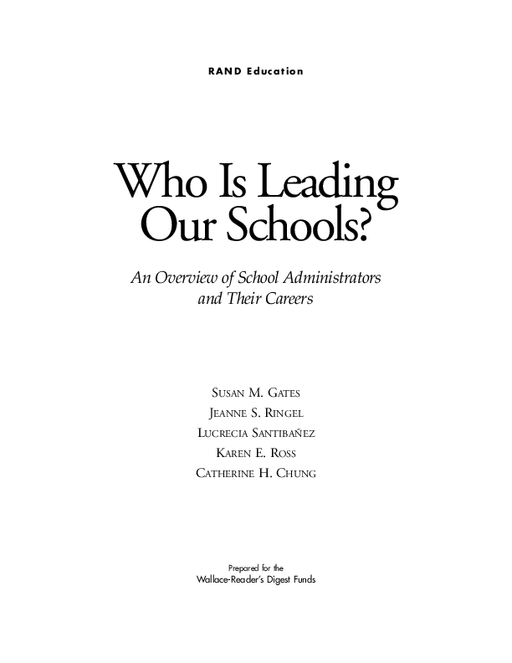Breadcrumb
- Wallace
- Reports
- Who Is Leading Our Schools An Ov...
Who is Leading Our Schools
An Overview of School Administrators and Their Careers

- Author(s)
- Susan M. Gates, Jeanne S. Ringel, Lucrecia Santibanez, Karen E. Ross, and Catherine H. Chung
- Publisher(s)
- RAND Corporation
- DOI Link
- https://doi.org/10.7249/MR1679
Summary
How we did this
RAND began its study by developing a conceptual framework for understanding the careers of school administrators. The researchers then used the framework to summarize what is currently known about school administrators and their careers and to address key questions. Their summary draws on a broad review of the existing literature as well as their analyses of career-related issues as salary, career paths, and attitudes using the National Center for Education Statistics (NCES) Schools and Staffing Survey (SASS) data from the U.S. Department of Education and the Current Population Survey (CPS) from the U.S. Census Bureau.
This study provides descriptive information about school administrators and their careers. The researchers examined their characteristics, movement within the school administrator field, and incentives for movements into and out of school administrator positions.
What is Known About the Careers of School Administrators?
A main finding is that the number of school administrators is stable, but the profession is aging. Public schools are hiring increasingly older people into the principalship, and relatively few principals remain in their positions beyond age 55.
Another finding is that there is little evidence that school administrators are being lured into other career fields. There also appears to be no major shift factors that could influence entry into and exit from the school administration field. For example, the research found that compensation kept pace with that of other managerial professions in the public and private sectors.
Overall, individuals appear to have financial incentives to move into and through the school administrative field. Teaching is the most common gateway into most of these positions.
The researchers also found no evidence that the more-experienced principals were choosing not to work in urban schools with students from marginalized communities.
Policy Implications
The research raises some issues for policymakers and school administrators to consider.
- Schools, districts, and states may benefit from thinking of how to reach out to younger people to create a group of administrators whose careers can be longer. At the same time, public school systems could look at their retirement systems, which appear to create incentives for individuals to retire or leave the education system at a relatively young age.
- Local-level data and analyses of the careers of school administrators are needed. The research suggests there are important differences in the challenges faced by different states. It provides support for a state-level analysis of school administrators.
- Policymakers should further examine the forms of entry into the school administrative field. Since teaching is the main gateway to school administration, schools and districts need to attract high-quality potential administrators into the teaching pool and to ensure that teachers have an incentive to move into school administration. If policymakers are serious about drawing people from outside education into school administration, they need to remove barriers like certification requirements and informal district hiring practices.

For the most part, tomorrow’s administrators are today’s teachers, a fact that has several important implications for policymakers to consider.
Key Takeaways
- A study of the rates at which school administrators leave their professional field provided no evidence of a mass exodus.
- However, it did suggest that the profession is aging. Schools, districts, and states may benefit from thinking of how to reach out to younger people to create a group of administrators whose careers can be longer.
- To avoid a future potential supply crisis, schools and districts may consider things like financial incentives and hiring school administrators outside of the education sector.
Visualizations
Rates of Exit from School Administration, 1983–1999
What We Don't Know
Although the existing data provide a useful starting point for developing an understanding of school administrative careers, they do not provide a long-run look at the careers of individual administrators. Better, longitudinal data are needed to conduct a more robust and complete assessment of these careers.
One major item that limited the analysis was the lack of information on principal quality. Although performance review processes may exist for school administrators in some schools and districts, the data are not available in any systematic way that makes them usable for research or comparison purposes. Other approaches to measuring principal quality are possible, but they pose important challenges. This is an area worthy of future attention, according to the researchers.
Also, the existing literature focus on describing the current stock of school administrators and ignore career moves and the factors influencing those moves. A more thorough understanding of the flows and how they could be influenced by policy would be useful to policymakers and educational administrators.
Additionally, local-level data and analyses of the careers of school administrators are needed. The research suggests there are important differences in the challenges faced by different states, and it provides support for a state-level analysis of school administrators.

